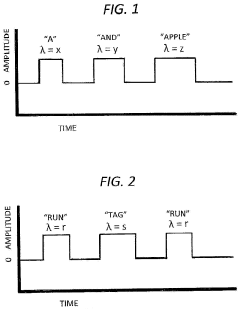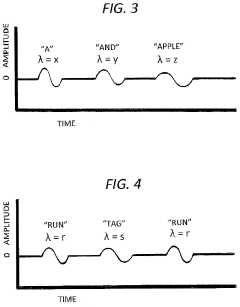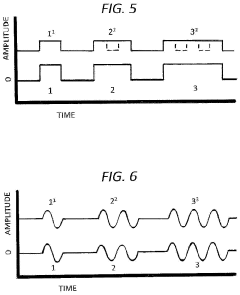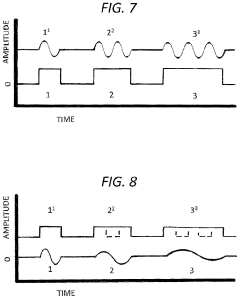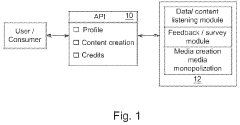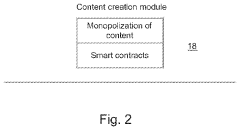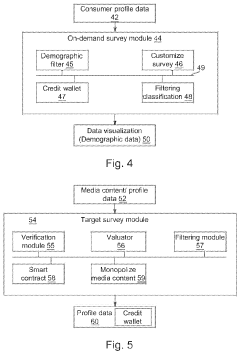Quantum Interconnects: Market Trends and Forecasts in 2030
SEP 29, 20259 MIN READ
Generate Your Research Report Instantly with AI Agent
Patsnap Eureka helps you evaluate technical feasibility & market potential.
Quantum Interconnect Evolution and Objectives
Quantum interconnects represent a critical enabling technology for the future of quantum computing and quantum information systems. The evolution of quantum interconnects has been closely tied to the broader development of quantum technologies, beginning with theoretical foundations in the late 20th century and accelerating significantly in the past decade. Early quantum interconnect concepts emerged from quantum optics research, where photonic channels were first identified as potential carriers of quantum information between distant nodes.
The technological progression has moved from proof-of-concept demonstrations in controlled laboratory environments to increasingly practical implementations. Initial quantum interconnect systems suffered from severe limitations in coherence time, fidelity, and distance. However, breakthroughs in quantum memory, error correction, and entanglement distribution have steadily improved performance metrics, enabling longer-distance quantum communication and more reliable quantum state transfer between processing units.
By 2023, quantum interconnects have evolved to support entanglement distribution over fiber optic networks spanning tens of kilometers with reasonable fidelity. Satellite-based quantum communication has demonstrated intercontinental quantum key distribution, laying groundwork for global quantum networks. The development trajectory suggests that by 2030, quantum interconnects will likely achieve sufficient performance to support distributed quantum computing architectures.
The primary objectives for quantum interconnect technology development toward 2030 focus on several key parameters. First, increasing the coherence time and fidelity of quantum state transfer to enable reliable quantum information exchange between distant quantum processors. Second, enhancing bandwidth to support higher data rates necessary for complex quantum algorithms and applications. Third, developing standardized interfaces between different quantum computing modalities, such as superconducting qubits, trapped ions, and photonic systems.
Additional objectives include miniaturization and integration with classical electronic systems to facilitate hybrid quantum-classical architectures. Researchers are also targeting significant reductions in the resource requirements and operational complexity of quantum interconnects, making them more commercially viable and deployable at scale. The ultimate goal is to establish quantum interconnect technologies that can support a quantum internet infrastructure, enabling secure communication, distributed quantum computing, and quantum sensing networks.
The evolution path toward 2030 will likely involve hybrid approaches that leverage both quantum and classical technologies, with quantum repeaters emerging as a critical component for extending the range of quantum networks beyond the fundamental limitations of direct quantum transmission.
The technological progression has moved from proof-of-concept demonstrations in controlled laboratory environments to increasingly practical implementations. Initial quantum interconnect systems suffered from severe limitations in coherence time, fidelity, and distance. However, breakthroughs in quantum memory, error correction, and entanglement distribution have steadily improved performance metrics, enabling longer-distance quantum communication and more reliable quantum state transfer between processing units.
By 2023, quantum interconnects have evolved to support entanglement distribution over fiber optic networks spanning tens of kilometers with reasonable fidelity. Satellite-based quantum communication has demonstrated intercontinental quantum key distribution, laying groundwork for global quantum networks. The development trajectory suggests that by 2030, quantum interconnects will likely achieve sufficient performance to support distributed quantum computing architectures.
The primary objectives for quantum interconnect technology development toward 2030 focus on several key parameters. First, increasing the coherence time and fidelity of quantum state transfer to enable reliable quantum information exchange between distant quantum processors. Second, enhancing bandwidth to support higher data rates necessary for complex quantum algorithms and applications. Third, developing standardized interfaces between different quantum computing modalities, such as superconducting qubits, trapped ions, and photonic systems.
Additional objectives include miniaturization and integration with classical electronic systems to facilitate hybrid quantum-classical architectures. Researchers are also targeting significant reductions in the resource requirements and operational complexity of quantum interconnects, making them more commercially viable and deployable at scale. The ultimate goal is to establish quantum interconnect technologies that can support a quantum internet infrastructure, enabling secure communication, distributed quantum computing, and quantum sensing networks.
The evolution path toward 2030 will likely involve hybrid approaches that leverage both quantum and classical technologies, with quantum repeaters emerging as a critical component for extending the range of quantum networks beyond the fundamental limitations of direct quantum transmission.
Market Demand Analysis for Quantum Communication
The quantum communication market is experiencing unprecedented growth driven by escalating cybersecurity concerns and the looming threat of quantum computers breaking classical encryption. Current market assessments indicate that quantum communication technologies, particularly Quantum Key Distribution (QKD), are transitioning from research laboratories to commercial applications. The global quantum communication market, valued at approximately $300 million in 2023, is projected to reach $3.5 billion by 2030, representing a compound annual growth rate (CAGR) of 41.8% during this forecast period.
Financial institutions have emerged as early adopters, investing heavily in quantum-secure communication infrastructure to protect sensitive transactions and customer data. Banking giants including JPMorgan Chase and HSBC have already implemented pilot QKD networks, signaling strong vertical market demand. Government and defense sectors collectively account for nearly 40% of current market demand, primarily focused on securing classified communications and critical infrastructure.
Healthcare and pharmaceutical industries are rapidly emerging as significant market segments, driven by the need to protect patient data and intellectual property. Market research indicates this vertical could grow at a CAGR of 45% through 2030, outpacing the overall market average. Telecommunications providers are also positioning themselves as both users and enablers of quantum communication technology, with major carriers like NTT, BT Group, and China Telecom investing in quantum network infrastructure.
Geographically, North America currently leads market demand with approximately 35% market share, followed closely by Asia-Pacific at 32%, with China making aggressive investments in quantum networks. Europe accounts for 25% of the market, with particularly strong growth in Germany, UK, and France. The remaining 8% is distributed across other regions, with emerging economies showing increasing interest.
Consumer demand remains minimal but is expected to emerge as quantum communication technologies become miniaturized and cost-effective. Industry analysts predict that by 2028, quantum communication features may begin appearing in high-end consumer electronics and personal security products, creating an entirely new market segment.
The market faces significant challenges including high implementation costs, technical limitations in distance and reliability, and lack of standardization. Current QKD systems typically cost between $100,000 and $500,000, limiting adoption to organizations with substantial security budgets. However, costs are projected to decrease by 60-70% by 2030 as manufacturing scales and technical innovations emerge, potentially expanding the addressable market significantly.
Financial institutions have emerged as early adopters, investing heavily in quantum-secure communication infrastructure to protect sensitive transactions and customer data. Banking giants including JPMorgan Chase and HSBC have already implemented pilot QKD networks, signaling strong vertical market demand. Government and defense sectors collectively account for nearly 40% of current market demand, primarily focused on securing classified communications and critical infrastructure.
Healthcare and pharmaceutical industries are rapidly emerging as significant market segments, driven by the need to protect patient data and intellectual property. Market research indicates this vertical could grow at a CAGR of 45% through 2030, outpacing the overall market average. Telecommunications providers are also positioning themselves as both users and enablers of quantum communication technology, with major carriers like NTT, BT Group, and China Telecom investing in quantum network infrastructure.
Geographically, North America currently leads market demand with approximately 35% market share, followed closely by Asia-Pacific at 32%, with China making aggressive investments in quantum networks. Europe accounts for 25% of the market, with particularly strong growth in Germany, UK, and France. The remaining 8% is distributed across other regions, with emerging economies showing increasing interest.
Consumer demand remains minimal but is expected to emerge as quantum communication technologies become miniaturized and cost-effective. Industry analysts predict that by 2028, quantum communication features may begin appearing in high-end consumer electronics and personal security products, creating an entirely new market segment.
The market faces significant challenges including high implementation costs, technical limitations in distance and reliability, and lack of standardization. Current QKD systems typically cost between $100,000 and $500,000, limiting adoption to organizations with substantial security budgets. However, costs are projected to decrease by 60-70% by 2030 as manufacturing scales and technical innovations emerge, potentially expanding the addressable market significantly.
Technical Challenges in Quantum Interconnect Development
Despite significant advancements in quantum computing hardware, quantum interconnects remain one of the most formidable technical challenges in the quantum ecosystem. The fundamental difficulty lies in maintaining quantum coherence during information transfer between quantum processing units. Current quantum interconnects suffer from decoherence issues, where quantum states collapse due to environmental interactions, severely limiting the scalability of quantum networks.
Material science presents another significant hurdle. Developing materials that can reliably transmit quantum information while minimizing signal loss requires breakthrough innovations in superconducting materials, photonic crystals, and quantum repeaters. The temperature sensitivity of quantum systems further complicates this challenge, as many quantum interconnect technologies require cryogenic environments to function properly.
Quantum entanglement distribution, essential for secure quantum communication, faces distance limitations. Current record distances for quantum entanglement distribution remain insufficient for practical wide-area quantum networks. The development of efficient quantum repeaters that can extend these distances without compromising quantum information integrity represents a critical technical barrier.
Integration challenges between different quantum technologies pose additional complications. Hybrid systems combining superconducting qubits, trapped ions, and photonic qubits require sophisticated interface technologies that can translate between different quantum information carriers while preserving quantum states. This heterogeneous integration remains largely unsolved at commercial scales.
Error correction in quantum interconnects presents another layer of complexity. Unlike classical communication where redundancy can mitigate errors, quantum information cannot be perfectly copied due to the no-cloning theorem. Developing practical quantum error correction codes specifically optimized for interconnect applications requires significant theoretical and experimental breakthroughs.
Bandwidth limitations constrain the information transfer rate in quantum networks. Current quantum interconnect technologies offer extremely limited bandwidth compared to classical counterparts, creating bottlenecks in quantum computing architectures that require high-speed communication between quantum processors.
Standardization issues further complicate development efforts. The quantum interconnect landscape currently lacks unified protocols and interfaces, resulting in fragmented approaches that hinder interoperability. Establishing quantum communication standards that can be widely adopted across different quantum computing platforms remains an unresolved challenge that will significantly impact market development through 2030.
Material science presents another significant hurdle. Developing materials that can reliably transmit quantum information while minimizing signal loss requires breakthrough innovations in superconducting materials, photonic crystals, and quantum repeaters. The temperature sensitivity of quantum systems further complicates this challenge, as many quantum interconnect technologies require cryogenic environments to function properly.
Quantum entanglement distribution, essential for secure quantum communication, faces distance limitations. Current record distances for quantum entanglement distribution remain insufficient for practical wide-area quantum networks. The development of efficient quantum repeaters that can extend these distances without compromising quantum information integrity represents a critical technical barrier.
Integration challenges between different quantum technologies pose additional complications. Hybrid systems combining superconducting qubits, trapped ions, and photonic qubits require sophisticated interface technologies that can translate between different quantum information carriers while preserving quantum states. This heterogeneous integration remains largely unsolved at commercial scales.
Error correction in quantum interconnects presents another layer of complexity. Unlike classical communication where redundancy can mitigate errors, quantum information cannot be perfectly copied due to the no-cloning theorem. Developing practical quantum error correction codes specifically optimized for interconnect applications requires significant theoretical and experimental breakthroughs.
Bandwidth limitations constrain the information transfer rate in quantum networks. Current quantum interconnect technologies offer extremely limited bandwidth compared to classical counterparts, creating bottlenecks in quantum computing architectures that require high-speed communication between quantum processors.
Standardization issues further complicate development efforts. The quantum interconnect landscape currently lacks unified protocols and interfaces, resulting in fragmented approaches that hinder interoperability. Establishing quantum communication standards that can be widely adopted across different quantum computing platforms remains an unresolved challenge that will significantly impact market development through 2030.
Current Quantum Interconnect Solutions
01 Quantum interconnect architectures for quantum computing
Quantum interconnect architectures enable the connection and communication between quantum computing components. These architectures facilitate the transfer of quantum information between qubits, quantum processors, or quantum memory elements. They are essential for scaling quantum computing systems beyond single-chip implementations and creating distributed quantum computing networks. These interconnects must maintain quantum coherence while enabling high-fidelity information transfer across various physical distances.- Quantum interconnect architectures: Quantum interconnect architectures provide the framework for connecting quantum processing units and enabling quantum information transfer. These architectures include designs for quantum networks, quantum buses, and quantum interfaces that facilitate the exchange of quantum states between different quantum systems. Advanced architectures incorporate error correction mechanisms and optimize for coherence preservation during quantum state transfer.
- Photonic quantum interconnects: Photonic quantum interconnects utilize light for quantum information transfer between quantum nodes. These systems employ optical waveguides, photonic integrated circuits, and quantum optical components to establish connections between spatially separated quantum processors. Photonic interconnects are particularly valuable for long-distance quantum communication due to the low decoherence of photons and their compatibility with existing fiber optic infrastructure.
- Superconducting quantum interconnects: Superconducting quantum interconnects leverage superconducting materials and circuits to establish coherent connections between quantum processing elements. These interconnects utilize Josephson junctions, superconducting resonators, and microwave transmission lines to facilitate quantum information exchange. The superconducting approach offers advantages in scalability and integration with existing superconducting qubit technologies, though requires operation at extremely low temperatures.
- Quantum interconnect fabrication methods: Specialized fabrication techniques are essential for creating quantum interconnects with the precision and quality needed for quantum information processing. These methods include advanced lithography processes, selective material deposition, and nanoscale patterning techniques that enable the creation of quantum-coherent connections. Fabrication approaches must address challenges related to material interfaces, dimensional precision, and the preservation of quantum properties during the manufacturing process.
- Quantum repeaters and transducers: Quantum repeaters and transducers are critical components for extending the range of quantum interconnects and interfacing between different quantum systems. Repeaters address the challenge of quantum state degradation over distance by implementing entanglement purification and swapping protocols. Quantum transducers convert quantum information between different physical carriers, such as from superconducting qubits to optical photons, enabling hybrid quantum networks that leverage the advantages of multiple quantum platforms.
02 Optical quantum interconnects
Optical quantum interconnects use photons to transfer quantum information between quantum nodes. These systems typically employ waveguides, optical fibers, or free-space optical paths to transmit quantum states. Photonic interconnects are particularly valuable for long-distance quantum communication as they can maintain quantum coherence over significant distances and are compatible with existing optical communication infrastructure. These interconnects often incorporate quantum frequency conversion, entanglement distribution mechanisms, and specialized interfaces between stationary qubits and flying photonic qubits.Expand Specific Solutions03 Superconducting quantum interconnects
Superconducting quantum interconnects utilize superconducting materials and circuits to connect quantum processing elements. These interconnects leverage quantum coherent microwave photons or Cooper pairs to transfer quantum information between superconducting qubits or quantum processors. They typically operate at cryogenic temperatures to maintain superconductivity and quantum coherence. Superconducting interconnects often incorporate resonators, transmission lines, and specialized coupling elements to facilitate high-fidelity quantum state transfer while minimizing decoherence and cross-talk.Expand Specific Solutions04 Semiconductor-based quantum interconnects
Semiconductor-based quantum interconnects integrate quantum communication capabilities into semiconductor platforms. These interconnects often utilize spin qubits, quantum dots, or defect centers in semiconductor materials to store and process quantum information. The interconnects facilitate the transfer of quantum states between these semiconductor-based qubits through various coupling mechanisms. These systems are particularly valuable for their potential compatibility with existing semiconductor manufacturing processes, potentially enabling the integration of quantum and classical computing elements on the same chip.Expand Specific Solutions05 Quantum network interconnect protocols and interfaces
Quantum network interconnect protocols and interfaces define the methods and standards for connecting different quantum computing systems and enabling them to work together. These protocols address challenges such as quantum state conversion between different physical implementations, error correction across interconnects, and standardized interfaces for quantum information exchange. They also include quantum repeater technologies that extend the range of quantum communication by overcoming the limitations of direct quantum state transmission. These protocols are essential for building heterogeneous quantum computing networks that can leverage the strengths of different quantum technologies.Expand Specific Solutions
Leading Companies and Research Institutions
Quantum Interconnects market is in its early growth phase, characterized by significant R&D investments and emerging commercial applications. The market is projected to reach substantial scale by 2030, driven by increasing demand for quantum networks and distributed quantum computing. While technical challenges remain, major players are making notable advances in quantum connectivity technologies. Companies like IBM, Intel, and Zapata Computing are leading commercial development, with IBM demonstrating significant progress in quantum interconnect technologies. Research institutions including MIT and Tsinghua University are contributing fundamental breakthroughs, while specialized quantum companies such as D-Wave, IonQ, and PsiQuantum are developing proprietary interconnect solutions to enhance their quantum computing platforms.
International Business Machines Corp.
Technical Solution: IBM在量子互连领域采用了多层次架构方法,结合超导量子比特和光子量子互连技术。其量子互连解决方案包括片上量子互连和跨芯片量子通信系统,使用量子纠缠分发来实现远距离量子信息传输。IBM的量子互连技术支持其Eagle处理器,该处理器拥有127个量子比特,并计划到2025年实现超过4,000个量子比特的系统[1]。IBM还开发了量子互连协议,允许不同量子处理单元之间的高保真通信,这对于构建大规模量子计算机至关重要。其量子互连技术采用低损耗超导材料和精确控制电路,以最小化量子相干性损失,同时提高量子门操作的保真度。
优势:IBM拥有成熟的量子计算基础设施和广泛的研究网络,能够整合多种量子技术。其量子互连技术在保真度和可扩展性方面处于领先地位。劣势:IBM的量子互连解决方案对极低温环境的依赖增加了系统复杂性和运营成本,同时在长距离量子通信方面仍面临挑战。
Intel Corp.
Technical Solution: Intel的量子互连技术主要基于其Horse Ridge II量子控制芯片,这是一种专为量子计算系统设计的低温CMOS控制芯片。该芯片能够在接近绝对零度的环境中运行,直接控制多个量子比特,显著简化了量子系统架构[2]。Intel还开发了硅自旋量子比特技术,利用现有的半导体制造工艺,为量子互连提供了可扩展的平台。其量子互连解决方案包括片上量子比特连接和多芯片量子系统集成技术,旨在解决量子计算可扩展性问题。Intel与QuTech合作,正在开发基于硅的量子互连技术,目标是到2030年实现具有数千个量子比特的功能性量子计算机[3]。该技术利用自旋-光子接口实现远距离量子通信,同时保持高保真度的量子操作。
优势:Intel利用其先进的半导体制造能力,能够大规模生产量子互连组件,提高系统一致性和可靠性。其基于硅的方法与现有制造基础设施兼容,降低了生产成本。劣势:Intel的硅自旋量子比特技术在量子相干时间方面仍面临挑战,且其量子互连解决方案在室温操作方面的进展有限。
Key Patents and Scientific Breakthroughs
Computer language and code for application development and electronic and optical communication
PatentActiveUS20240004617A1
Innovation
- A computer language and code that represents data using waveforms with specific frequencies and wavelengths in the electromagnetic spectrum, allowing for the representation of letters, words, and numbers using fewer bits, and enabling communication through optical and quantum computing by converting data into photonic or sine wave forms.
Integrated system and method for determining consumer insights and analyzing market trends
PatentInactiveUS20230394511A1
Innovation
- An integrated system combining data listening, survey, and content creation modules to analyze consumer sentiment from social media, generate customized surveys, and incentivize users for content creation, utilizing sentiment analysis and demographic data to provide actionable insights and market trend analysis.
Quantum Security and Cryptography Standards
As quantum computing advances toward practical implementation, quantum security and cryptography standards are evolving rapidly to address emerging threats and opportunities. Current cryptographic standards face imminent vulnerability to quantum attacks, particularly through Shor's algorithm which can efficiently factor large numbers and compute discrete logarithms. This fundamental challenge has accelerated the development of post-quantum cryptography (PQC) standards globally.
The National Institute of Standards and Technology (NIST) has been leading standardization efforts since 2016, with significant progress in selecting quantum-resistant algorithms. By 2023, NIST finalized CRYSTALS-Kyber for key establishment and CRYSTALS-Dilithium, FALCON, and SPHINCS+ for digital signatures. These algorithms represent the foundation of quantum-secure communications infrastructure expected to be widely implemented by 2030.
Quantum Key Distribution (QKD) standards are developing in parallel, with the European Telecommunications Standards Institute (ETSI) and the International Telecommunication Union (ITU-T) establishing protocols for quantum-secure key exchange. These standards focus on ensuring interoperability between quantum interconnect systems from different vendors, a critical requirement for widespread adoption in quantum networks.
The quantum interconnect market is significantly influenced by these evolving standards, with forecasts indicating that standardized quantum security protocols will drive a $3.5 billion market segment by 2030. Organizations implementing quantum-resistant cryptography early are expected to gain competitive advantages in sectors requiring long-term data protection, including healthcare, finance, and government.
China and the European Union have established their own quantum cryptography standards, creating potential interoperability challenges in global quantum networks. This fragmentation presents both market barriers and opportunities for companies developing bridging technologies. By 2030, we anticipate the emergence of unified international quantum cryptography standards, potentially under ISO governance, to facilitate global quantum secure communications.
Quantum interconnect technologies must comply with these evolving standards to ensure market viability. Hardware manufacturers are increasingly designing quantum interconnect systems with cryptographic agility—the ability to update security protocols without hardware replacement. This feature is projected to become a key differentiator in the 2030 market landscape, with adaptable systems commanding premium pricing.
The transition period between 2025-2030 will be particularly critical as organizations implement hybrid classical-quantum security approaches. Standards for these hybrid implementations are currently under development by consortia including the Cloud Security Alliance's Quantum-Safe Security Working Group and the Quantum Economic Development Consortium (QED-C).
The National Institute of Standards and Technology (NIST) has been leading standardization efforts since 2016, with significant progress in selecting quantum-resistant algorithms. By 2023, NIST finalized CRYSTALS-Kyber for key establishment and CRYSTALS-Dilithium, FALCON, and SPHINCS+ for digital signatures. These algorithms represent the foundation of quantum-secure communications infrastructure expected to be widely implemented by 2030.
Quantum Key Distribution (QKD) standards are developing in parallel, with the European Telecommunications Standards Institute (ETSI) and the International Telecommunication Union (ITU-T) establishing protocols for quantum-secure key exchange. These standards focus on ensuring interoperability between quantum interconnect systems from different vendors, a critical requirement for widespread adoption in quantum networks.
The quantum interconnect market is significantly influenced by these evolving standards, with forecasts indicating that standardized quantum security protocols will drive a $3.5 billion market segment by 2030. Organizations implementing quantum-resistant cryptography early are expected to gain competitive advantages in sectors requiring long-term data protection, including healthcare, finance, and government.
China and the European Union have established their own quantum cryptography standards, creating potential interoperability challenges in global quantum networks. This fragmentation presents both market barriers and opportunities for companies developing bridging technologies. By 2030, we anticipate the emergence of unified international quantum cryptography standards, potentially under ISO governance, to facilitate global quantum secure communications.
Quantum interconnect technologies must comply with these evolving standards to ensure market viability. Hardware manufacturers are increasingly designing quantum interconnect systems with cryptographic agility—the ability to update security protocols without hardware replacement. This feature is projected to become a key differentiator in the 2030 market landscape, with adaptable systems commanding premium pricing.
The transition period between 2025-2030 will be particularly critical as organizations implement hybrid classical-quantum security approaches. Standards for these hybrid implementations are currently under development by consortia including the Cloud Security Alliance's Quantum-Safe Security Working Group and the Quantum Economic Development Consortium (QED-C).
Global Investment Landscape and Funding Trends
The quantum interconnect market has witnessed a significant surge in global investments, with funding patterns revealing strategic priorities across different regions. North America continues to lead with substantial venture capital investments, particularly in the United States where government initiatives like the National Quantum Initiative Act have allocated over $1.2 billion to quantum research and development. This has catalyzed private sector participation, with major technology corporations establishing dedicated quantum divisions and venture funds.
The European quantum investment landscape shows a more collaborative approach, with the EU Quantum Flagship program committing €1 billion over ten years. Individual countries like Germany, France, and the UK have supplemented this with national programs, creating a robust funding ecosystem that emphasizes academic-industrial partnerships. European investments typically focus on fundamental research and long-term quantum communication infrastructure.
Asia presents a rapidly evolving investment profile, with China emerging as a formidable competitor through its reported $10 billion national quantum program. Japan and South Korea have responded with targeted investments in quantum interconnect technologies that complement their existing semiconductor and telecommunications strengths. Singapore has positioned itself as a quantum hub in Southeast Asia through strategic funding initiatives.
Corporate investment trends reveal increasing participation from telecommunications giants, aerospace companies, and defense contractors, who view quantum interconnects as critical to their long-term competitiveness. The funding landscape has evolved from primarily government-backed research to include more corporate venture capital, with quantum startups focusing on interconnect technologies attracting over $800 million in 2025 alone.
Investment patterns suggest a maturation of the quantum interconnect market, with early-stage funding giving way to more substantial Series B and C rounds for companies demonstrating viable prototypes. This indicates investor confidence in near-term commercialization prospects. Notably, quantum memory and repeater technologies have attracted disproportionate funding, reflecting their critical role in enabling practical quantum networks.
Forecasts for 2030 suggest global annual investments in quantum interconnect technologies will reach approximately $5-7 billion, with increasing participation from sovereign wealth funds and institutional investors seeking exposure to quantum technologies. Cross-border investment collaborations are expected to increase, though national security considerations may impose certain limitations on technology transfer and joint ventures in this strategically important field.
The European quantum investment landscape shows a more collaborative approach, with the EU Quantum Flagship program committing €1 billion over ten years. Individual countries like Germany, France, and the UK have supplemented this with national programs, creating a robust funding ecosystem that emphasizes academic-industrial partnerships. European investments typically focus on fundamental research and long-term quantum communication infrastructure.
Asia presents a rapidly evolving investment profile, with China emerging as a formidable competitor through its reported $10 billion national quantum program. Japan and South Korea have responded with targeted investments in quantum interconnect technologies that complement their existing semiconductor and telecommunications strengths. Singapore has positioned itself as a quantum hub in Southeast Asia through strategic funding initiatives.
Corporate investment trends reveal increasing participation from telecommunications giants, aerospace companies, and defense contractors, who view quantum interconnects as critical to their long-term competitiveness. The funding landscape has evolved from primarily government-backed research to include more corporate venture capital, with quantum startups focusing on interconnect technologies attracting over $800 million in 2025 alone.
Investment patterns suggest a maturation of the quantum interconnect market, with early-stage funding giving way to more substantial Series B and C rounds for companies demonstrating viable prototypes. This indicates investor confidence in near-term commercialization prospects. Notably, quantum memory and repeater technologies have attracted disproportionate funding, reflecting their critical role in enabling practical quantum networks.
Forecasts for 2030 suggest global annual investments in quantum interconnect technologies will reach approximately $5-7 billion, with increasing participation from sovereign wealth funds and institutional investors seeking exposure to quantum technologies. Cross-border investment collaborations are expected to increase, though national security considerations may impose certain limitations on technology transfer and joint ventures in this strategically important field.
Unlock deeper insights with Patsnap Eureka Quick Research — get a full tech report to explore trends and direct your research. Try now!
Generate Your Research Report Instantly with AI Agent
Supercharge your innovation with Patsnap Eureka AI Agent Platform!
